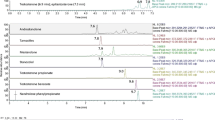Abstract
Growing interest among several horse-breeder associations has initiated the development of a screening procedure to test for anabolic agents in hair, which has the advantage over blood and urine specimens of allowing long-term detection. An analytical method was established to monitor in tails or manes several anabolic substances available as veterinary medicines or as so-called nutritional supplements (clenbuterol, different esters or prohormones of nandrolone and testosterone). The analytical procedure to detect steroids in hair samples consists of the following steps: decontamination of the hair strand or segment with methanol/water (1:1), milling, extraction of the hair material in an ultrasonic bath using methanol, purification by liquid–liquid extraction (n-pentane/methanol, 25:1) and HPLC cleanup, derivatisation of the relevant LC fractions with MSTFA, and measurement using GC-MS/MS technique. The first objective of our study was the detection of exogenous nandrolone (nortestosterone, NT) in the horse hair; therefore nandrolone-associated compounds [nandrolone dodecanoate administered intramuscularly (i.m.) and a mixture of 4-estrenediol and 4-estrenedione, transdermal] were administered to four geldings. The highest concentrations of NT following i.m. treatment were measured after 10 days in a 2-cm hair segment (up to 18 pg/mg); NT was detectable for up to 120 days and in some cases up to 330 days in tail hair (limit of detection 0.3 pg/mg). Following transdermal application, nandrolone as well as the administered prohormones were identified in tail and mane until the latest sampling at 3 months. Furthermore, untreated stallions (128) were investigated to estimate the range of endogenous levels of NT and testosterone (T) in hair. Maximum values of 3 pg/mg (NT) and 1 pg/mg (T) were quantified originating from endogenous formation in the male horse. Additionally, a possible relationship between steroid concentrations in hair specimens and the age of stallions was appraised. NT and T were not detected in hair samples of control geldings. Following nandrolone treatment of geldings, highest values in hair exceeded the endogenous amount detected in untreated stallions. Therefore comparison of concentrations measured in control samples with the estimated endogenous levels could give a clue to exogenous application in cases of abnormally high amounts of NT or T. The possibility of the evaluation of threshold values is discussed as a means to verify an exogenous administration of NT and T in hair samples. Furthermore, the detection of a synthetic substance in hair, e. g. the parent steroid ester by itself, would be unequivocal proof of an exogenous origin of NT or T and the previous medication of the stallion.





Similar content being viewed by others
Abbreviations
- NT:
-
Nandrolone, nortestosterone
- T:
-
Testosterone
- Td3:
-
Testosterone-d3
- LOD:
-
Limit of detection
References
Dehennin L, Bonnaire Y, Plou P (2002) J Chromatogr B Analyt Technol Biomed Life Sci 766(2):257–263
Houghton E, Copsey J, Dumasia MC, Haywood PE, Moss MS, Teale P (1984) Biomed Mass Spectrom 11(2):96–99
Dumasia MC, Houghton E, Jackiw M (1989) J Endocrinol 120(2):223–229
Houghton E (1977) Xenobiotica 7(11):683–693
Houghton E, Dumasia MC (1979) Xenobiotica 9(5):269–279
Kintz P, Cirimele V, Jeanneau T, Ludes B (1999) J Anal Toxicol 23(5):352–356
Thieme D, Grosse J, Sachs H, Mueller RK (2000) Forensic Sci Int 107(1–3):335–345
Schlupp A, Anielski P, Thieme D, Mueller RK, Meyer H, Ellendorff F (2004) Equine Vet J 36(2):118–122
Schlupp A (2003) Nachweis von Anabolika im Schweif– und Mähnenhaar von Pferden. PhD Thesis, Institute for Animal Science Mariensee, University of Veterinary Medicine, Hannover, Germany
Dunnett M, Lees P (2004) Equine Vet J 36(2):113–117
Houghton E (1992) Proceedings of the 9th international conference of racing analysts and veterinarians, New Orleans, pp 3–15
Horning S, Schaenzer W, Donike M (1994) Proceedings of the 12th workshop on dope analysis. Cologne (2):39–50
Popot MA, et al (2004) Proceedings of the 15th international conference of racing analysts and veterinarians, Dubai. Poster 41:258
Acknowledgements
This work was partially accomplished within the project “Anabolics in Horse Hair”, supported by the Federal Institute of Sports Science (Bonn, Germany, 0414/02/03/2002-2003). The expert care of the horses by J. Meier is gratefully acknowledged.
Author information
Authors and Affiliations
Corresponding author
Rights and permissions
About this article
Cite this article
Anielski, P., Thieme, D., Schlupp, A. et al. Detection of testosterone, nandrolone and precursors in horse hair. Anal Bioanal Chem 383, 903–908 (2005). https://doi.org/10.1007/s00216-005-0104-8
Received:
Revised:
Accepted:
Published:
Issue Date:
DOI: https://doi.org/10.1007/s00216-005-0104-8




